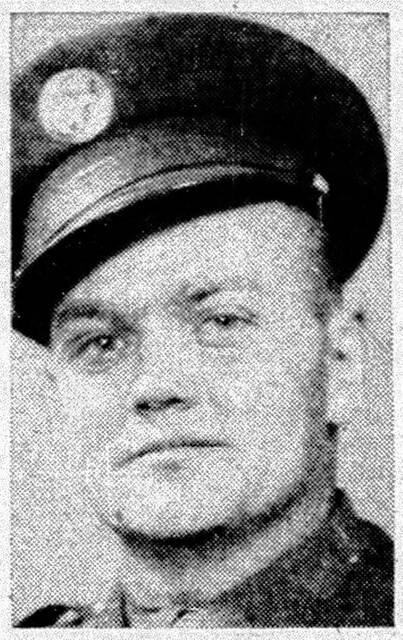In his 1875 poem “Amalfi” Henry Wadsworth Longfellow wrote of the Gulf of Salerno and its beautiful beach.
“This is an enchanted land
Bound the headlands far away
Sweeps the blue Salerian bay
With its sickle of white sand;”
For Pvt. Herman O. Knose of Jackson Township, Brown County, Indiana there was nothing scenic let alone romantic about the Salerno beach.
He and thousands of his fellow U.S. Fifth Army combatants would attest to that as they approached the Italian shore on the evening of Sept. 8, 1943. The next morning would commence the first Allied invasion of the European mainland.
Prior to his entering the Army Herman, a product of Jackson Township schools, had been employed at a company in Connersville as a welder. A Brown County Democrat item of April 3, 1941 updated his status and had him returning from Boston and taking a job as a gate keeper at the Brown County State Park. Late in the following year Herman entered the service. He had turned 29 in June of that year.
Herman underwent training at Fort Bragg, North Carolina and Camp Pickett in Virginia and subsequently was sent to North Africa where the Fifth Army would train for Operation Avalanche, the code name for the invasion of Italy at Salerno. The goal of Avalanche was to land at Salerno and then seize nearby Naples and eventually push north to Rome. The old Italian proverb, “See Naples and die,” certainly must have registered on the minds of some of the soldiers.
John Steinbeck, writing for the New York Herald Tribune, was with the Fifth Army as it trained in North Africa and he would also accompany them into Italy. While in North Africa he wrote of the soldiers as they trained for Avalanche.
“They did not talk about the war. They talked only of home and clean beds and white sheets and they talked of ice water and ice cream and places that did not smell of urine. Most of them let their minds dwell on snow banks and the sharp winds of Middle Western winter. But the red dust blew over them and dusted their skins and after a while they could not wash it all off any more. The war had narrowed down to their own small group of men and their own job,” Steinbeck wrote.
As with every soldier, each had his own more personal thoughts and with Herman it would have been of his wife, Gladys, and his recently widowed mother, Jane. Herman and Gladys had been married just over a year when he left for the Army and it was just prior to this that Herman’s father, Pearl, had passed away. Gladys had last heard from Herman in a letter dated Sept. 5 from Sicily which would have been just days prior to the Fifth Army’s embarkation for the Salerno invasion on Sept. 9.
As the days counted down towards that Fifth Army’s Italian D-Day there was positive news that the invasion of Salerno might not be as severe as previously thought. Mussolini, “Il Duce,” the Fascist leader of Italy, had been overthrown and the new government was ready to throw in the towel and exit the war. The thinking was that perhaps the Germans would now retreat to north of Rome in order to protect Italy’s industrial region leaving the south for the Allies to leisurely make their way up to Rome.
Some Allied leaders feared this hopeful news would dull the fighting edge of its soldiers but Fifth Army commander, Lt. General Mark Clark, was quoted as saying, “This operation will be a pursuit, not a battle!” German general, Field Marshal Kesselring was not of that opinion.
Before first light on Thursday, Sept. 9, 1943 600 Allied vessels approached the Salerno beachhead. Fellow Hoosier Harvey W. Hamilton of Madison in a letter home described the scene:
“They gave us pills to keep us from getting seasick, then loaded us on small boats, LCP’s (landing craft personnel), and lowered us to the water. There were about 25 in each boat. The sea was very rough and it tossed us around like chips while waiting for the signal to come ashore. Some of the boys were terribly seasick, one boy was vomiting on my feet, another vomiting over the side of the boat and others trying to vomit, so it was pretty much of a mess. Finally we reached shore and saw boats torn up, turned upside down and helmets floating around in the water and that told us lots of our boys had lost their lives.”
Lt. Gen. Mark Clark was wrong, like he would be through much of the Italian campaign. It would not be a “pursuit.” It would be a “slog.”
Field Marshal Kesslering had not headed north but had vacated the beach along with his forces and artillery for the mountains that enclosed the beach head. Kesslering called the mountains, “God’s gift to the gunners.” And it was from these mountains that the Germans rained artillery shells onto the beach resulting in many of those helmets floating along the shore. Herman did survive the initial landing, but the Allied foothold on the beach was a close-run thing.
The Fifth Army’s slender foothold on the Salerno beach continued through the ninth and 10th then into Sept. 11. The 11th would be an especially deadly day. Not just for the men of the Fifth Army clinging to the beach, but also off shore where the cruiser U. S. S. Savannah would suffer severe damages and the loss of 206 sailors when it was hit by a radio-controlled glide bomb released from a Nazi aircraft.
And it would be that same day that the name of Herman O. Knose would be added to a list that eventually would number some 1,084 Americans who made the ultimate sacrifice during the first Allied invasion of mainland Europe at Salerno and its sickle of white sand.
This tragic news had yet to arrive back home when the Oct. 7 edition of the Democrat reported that Gladys had spent the previous weekend with Herman’s mom, Jane. A main topic of conversation certainly would have been Herman’s most recent letter as well as what news there was of the Italian invasion.
Less than two weeks later however Gladys did receive news from the War Department that Herman was missing and then in early January the fateful news arrived that Herman had been killed in Italy, Sept. 11, 1943.
Herman was Jane and Pearl’s only son. Herman had one sister, Mrs. Harris Lewis of Eminence. Herman is buried at East Hill Cemetery in Morgantown.
The Sept. 13, 1945 edition of the Brown County Democrat carried an “In Memoriam” poem submitted by Gladys. The last stanza reads:
“My ‘Star of Hope’ so precious,
I call this Golden Star.
It shineth in my sorrow,
My loved one, lost at War.”
If you wish to learn more about this time period of World War II here are some books Jim Watkins recommends: “The Day of Battle, The War in Sicily and Italy, 1943-1944” in volume two of “The Liberation Trilogy” by by Rick Atkinson; “Once There Was a War” by John Steinbeck; and volume two of “Letters from Fighting Hoosiers” by Howard Henry Peckham.





